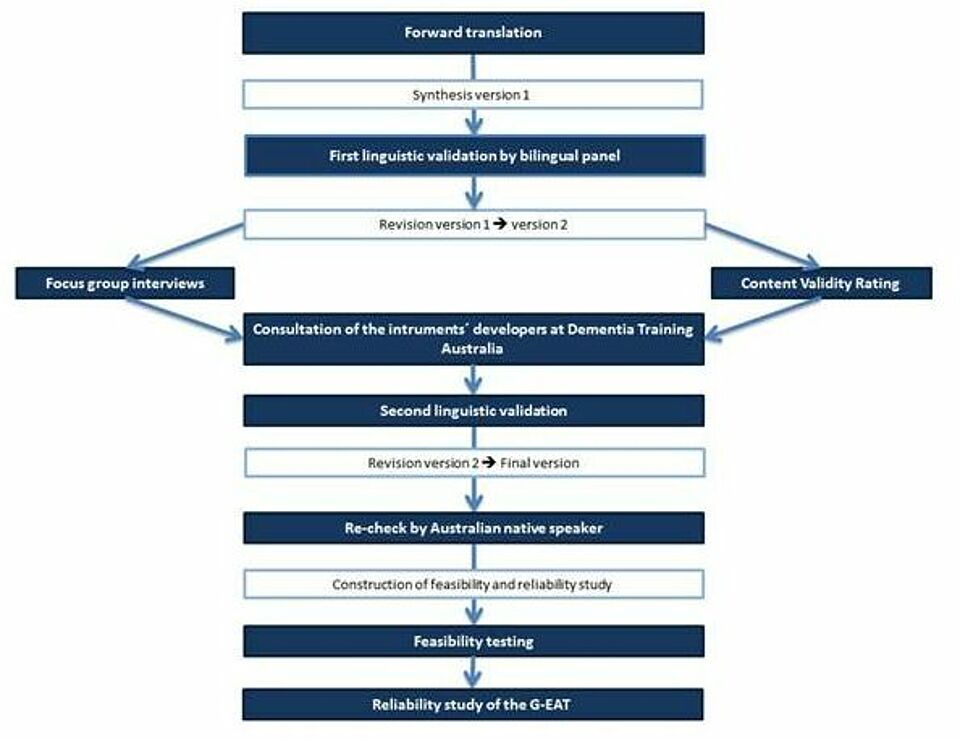Project Overview
| Duration: | 2017-2021 |
| Funding: | DZNE Witten |
| Project Management: | Dr. Bernhard Holle |
| Project Coordination: | Dr. Rebecca Palm |
| Project Staff: | Anne Fahsold |
Background
The relevance of the physical environment for dementia-specific care and the life of PwD in residential long-term care has been known as crucial for several decades. An adequate physical environment can maintain or enhance the remaining abilities of the residents and thus contribute to the improvement of quality of life. To date, no standardized, reliable and valid instrument is available for the assessment of the physical environment of PwD in residential long-term care in Germany, although an instrument has already been adapted, but its psychometric properties have shown to be unsatisfactory (see Institute for Gerontology, University of Heidelberg, 2006). In order to assess the adequacy of the physical environment in living units and to be able to make planned and dementia-specific adjustments as a result, the Australian "Environmental Audit Tool - High Care" should be available in an adapted form in future.
Project aims
The objectives of the project can be grouped into three areas:
1) Translation of the "Environmental Audit Tool - High Care" into German, including linguistic validation and cultural adaptation of the original instrument
2) Testing the feasibility of the adapted instrument "German Environmental Audit Tool (G-EAT)" in residential long-term care
3) Testing the interrater reliability of the German Environmental Audit Tool
Methods
1. Translation and adaptation of the Environmental Audit Tool - High Care
The adaptation of the original tool was carried out in a multi-step process based on the recommendations of the World Health Organization (1998). The translation and adaptation process involves both scientific experts and potential users from residential long-term care. The translation of the instrument was carried out by employees of DZNE. For linguistic validation colleagues with experience in translation processes were consulted. For the cultural adaptation, focus group interviews with long-term care practitioners were conducted and the Content Validity Index of G-EAT was calculated. Open questions from the existing process as well as an insight into the application of the instrument in Australia were clarified through a consultation at the University of Wollongong (Dementia Training Australia). Finally, the German language version of the instrument was reviewed by an Australian linguistics with regard to its equivalence to the Environmental Audit Tool -High Care.
2. Testing the feasibility of the G-EAT
Following the Australian approach, the instrument can be used by both researchers and practitioners. In order to identify information needs in the use of the G-EAT for both user groups and to be able to make adaptations, the instrument was evaluated regarding its feasibility in several living units. Thereby, the focus was on the duration of completing the form, integrating the assessment into the everyday life of the residents (prevention of disturbances) as well as the understanding of the respective questions of the G-EAT.
3. Interrater reliability testing of the G-EAT
The subsequent psychometric testing was carried out on 40 different living units in nursing homes in North Rhine-Westphalia. Two DZNE employees and two staff members working in the facility applied the instrument to one living unit per participating facility. After participation, all institutions received the results of the G-EAT in order to be able to discuss the strengths and weaknesses discovered in their built environment.
Expected Results
Following the completed phases 1 and 2 of the project, an adapted version of the EAT-HC, the German Environmental Audit Tool, now exists. The tool has already been applied in 40 living units in Germany area in the context of the interrater reliability test. In addition to the evaluation of interrater reliability, additional information was added to selected questions to simplify the G-EATs application for its users. The current analysis of the interrater reliability will provide further information about the possibility of scientific and practice-oriented application of the G-EAT in German residential long-term care. Also these results will form the basis for the further development of the instrument.
Kontakt


